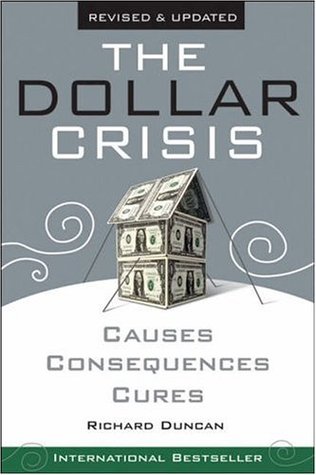The Dollar Crisis Summary
4 min read ⌚
 Causes, Consequences, Cures
Causes, Consequences, Cures
Economics is both an extremely important part of our lives and a notoriously unpredictable one. However, Richard Duncan’s “The Dollar Crisis” has proven a prophetic book so far. The problem is that there it includes many other predictions; and some of them are downright apocalyptic.
About Richard Duncan
Richard Duncan is an American economist. He has worked for the World Bank in Washington, D.C. and has consulted for the IMF. Duncan is the author of two more books in addition to “The Dollar Crisis”: “The Corruption of Capitalism” and “The New Depression.”
is an American economist. He has worked for the World Bank in Washington, D.C. and has consulted for the IMF. Duncan is the author of two more books in addition to “The Dollar Crisis”: “The Corruption of Capitalism” and “The New Depression.”
Read more at https://www.richardduncaneconomics.com/
“The Dollar Crisis Summary”
During the month of July in 1944, a host of over 700 delegates from over 40 nations of the world gathered at the Mount Washington Hotel in Bretton Woods, New Hampshire to discuss the future of the international monetary system.
The gathering, now known as the Bretton Woods Conference, would end up establishing the IBRD and IMF. More importantly, however – against the probably better judgement of the world’s leading economist, John Maynard Keynes – it will also implicitly establish the dollar as the international reserve currency, convertible to gold.
Thirty years later, Richard Nixon, shocked the world by decoupling the value of the dollar from the gold. And paper money started causing all sorts of problems.
And this is where “The Dollar Crisis,” Richard Duncan’s brilliant investigation in the problems of world economy, starts. It states that the international monetary system is flawed and that it would inevitably lead to a global economic collapse.
“The Dollar Crisis” was originally divided in four parts, but after some of its prophecies came true, its second edition added another, final chapter.
In the first chapter, “The Origin of Economic Bubbles” Duncan attempts to analyze what actually happened after the gold standard turned into the Dollar Standard. Unlike some conspiracists who like to think of the event as all bad, Duncan says that it actually enabled economic growth at an unprecedented scale.
However, this turned out to be the origin of the current problem. Economic growth in export-based countries such as China meant more dollars in their reserves; it also meant trade deficits in import-based ones such as the US.
How big of a trade deficit are we talking about?
Well, enormous! It now exceeds $1 million a minute!
Part Two, “Flaws in the Dollar Standard” explains why this should have been predicted from the start. In addition to clarifying what else should have been also foretold. Namely, worldwide asset price inflation and credit bubbles.
And, of course: US recession and a collapse of the dollar.
Part Three, “Global Recession and the Death of Monetarism” goes on to explore this scenario. In Duncan’s opinion, global recession and export-led growth would become history. Just like monetarism.
But, is there something we can do?
The fourth part of the book, “Policy Tools for the 21st Century,” tries to give an answer to this question. The recommendations go back to Keynes’ 1944 ideas, but sound original and even counter-intuitive. Contrary to libertarians who don’t believe in minimum wages and root for the return of the gold standard, Duncan suggests a global minimum wage and a global money supply control.
Some may deem these acts as a recipe for totalitarianism, but Duncan thinks that they are our only way out of an inevitable repeat of 1929.
And maybe we should believe him. Because, as he explains in the fifth part – added after the 2008-9 financial crisis – so far he has been right about… almost everything.
Key Lessons from “The Dollar Crisis”
1. The Pros and Cons of the Dollar Standard
2. Asset Inflation, Credit Bubbles, and the Dollar Collapse Are Inevitable
3. The Future of the Economy Must Be Balance-Based
The Pros and Cons of the Dollar Standard
In 1971, Nixon decoupled the value of the dollar from the reserves of gold available. Thus, he inaugurated the age of the Dollar Standard. It is what allowed for an unprecedented scale of economic growth, especially in export-based developing nations. However, it is also what has led to the economic crisis of 2008.
Asset Inflation, Credit Bubbles, and the Dollar Collapse Are Inevitable
And, in Duncan’s opinion, this is merely the beginning. Because of U.S.’s large trade deficit, asset price inflation, and credit bubbles are already our present. The very recent future is the collapse of the dollar.
And with it (since more than 70% of world’s money are dollars) world’s economy as well.
The Future of the Economy Must Be Balance-Based
When money keeps rolling in and out, countries go mayhem. And when that money is the national money of a single country, there’s an inherent fundamental imbalance: that country has to print out more and more money to fulfill the world’s demands, leading to trade deficits and a possible apocalyptic scenario.
Strangely enough, John Maynard Keynes predicted this back in 1944. And he advised for a system which will produce debtor-creditor equality and a global bank with its own currency, the bancor. The U.S. didn’t like it back then, but this may cause its demise very soon.The global economy is in a state of extreme disequilibrium. Share on X
In order to repair the imbalance now, Duncan thinks that the world must do two things straight away. First of all, accept the Keynes plan for a global bank. And secondly, introduce global minimum wage as a further regulator and balancer.
Otherwise – it’s going to get very, very serious.
Like this summary? We’d Like to invite you to download our free 12 min app, for more amazing summaries and audiobooks.
“The Dollar Crisis” Quotes
The global economy is in a state of extreme disequilibrium. Share on X Those crisp green pieces of paper have acted as high-powered money as they entered the world’s banking systems – just as gold would have. Share on X When bubbles explode, banks fail. Share on X The overindebted American economy has entered a recession that is likely to be as extreme and prolonged as the economic boom that preceded it. Share on X We have a global economy…it cannot be ‘us against them.’ We really are in this together – economically, socially and even environmentally. Share on X
Emir is the Head of Marketing at 12min. In his spare time, he loves to meditate and play soccer.


 Causes, Consequences, Cures
Causes, Consequences, Cures



